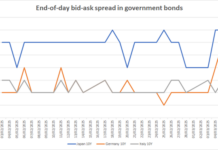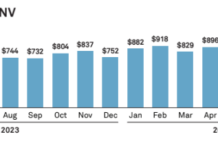Davide Masi, fixed income and currencies product manager, and Vassily Pascalis, senior vice president, fixed income sales at Eurex, discuss developing the asset class and the opportunities for firms across the global market.
Eurex first launched Credit Index Futures in 2021 with the EURO Investment Grade contract. The product suite has now expanded to cover new currencies and underlyings. As of August 2024, it has traded a total notional volume of EUR 26.7bn. This September, the exchange will expand the asset class further with the USD Corporate Bond index future.
What does Eurex offer in Credit Derivatives and what’s new?

Masi: Eurex launched Credit Index Futures, which are futures on corporate bond indices, in 2021. These products allow investors to take long or short exposure on a Bloomberg fixed income benchmark via a futures contract.
We started with EURO Investment Grade index futures and then expanded into EURO High Yield in 2022. In February, we launched GBP Corporate Index futures as well as USD Emerging Market Sovereign Index futures. Now we are completing our global product suite with the launch of USD Investment Grade and USD High Yield Index futures.
How do Credit Index Futures compare with other macro investment tools?
Masi: Credit default swaps (CDS) as well as CDS indices, and total return swaps on fixed income indices are well established products. In the cash market, fixed income ETFs are the most mainstream instrument to get exposure on benchmark indices.
Total return swaps on fixed income indices are the closest product to Credit Index Futures. The main difference is that total return swaps are bilaterally traded and uncleared while Credit Index Futures are cleared at Eurex Clearing and provide investors with full price transparency via Eurex’s orderbook. Additionally, they are marked-to-market daily, which ensures that our investors have clear visibility on the profit and loss (P&L) of their positions.
Fixed income ETFs, like Credit Index Futures, are an exchange-traded product featuring deep liquidity both on and off-book. The greatest difference lies in that they are physical securities and therefore they do not offer leverage. Credit Index Futures provide investors with a way to get efficient and leveraged exposure and are therefore operationally easier to use to take a leveraged long (or short) exposure.

Pascalis: Compared to CDS indices, Eurex Credit Index Futures provide exposure to an index of corporate bonds, hence the position would entail both credit risk and interest rate risk.
The index methodology of the two products is also different. CDS indices typically comprise of a limited number of issuers that are equally weighted and the index composition is rebalanced once every six months.
Eurex Credit Index Futures use benchmark indices representing the most invested Fixed Income asset classes as the underlying. Within each index, issuers are weighted according to the market cap that they represent in the index and the indices are rebalanced monthly.
Why is it only over the past few years that listed futures in credit have been launched?
Masi: There are three main trends that have facilitated the launch and development of Eurex Credit Index Futures. Firstly, the electronification trend in the underlying corporate bond market has unlocked deep liquidity pools for investors to trade, and has seen electronic liquidity providers enter the market.
This alongside the growth of the fixed income ETF market has prompted market makers to develop the technology to efficiently price in real time securities that are made of 1000s of different corporate bonds, including futures on bond indices.
Secondly, we have seen a significant increase in demand from the buy-side, who recognised the potential of Credit Fixed Income Futures to gain exposure to an asset class that they were unable to trade previously in an exchange-traded environment. Third, the ability of sell-side institutions to offer and price the product, which is linked to the other two factors, has improved significantly.
What was the motivation to expand the offering globally?
Masi: Our objective since we launched the first Credit Index Futures was to create a market for our customer base to invest into global fixed income benchmarks.
This year’s inclusion of Emerging Markets and US Credit Index futures was the logical next step for us. Our client base is supportive and enthusiastic about the new launches and we expect a wider, global client base to be receptive and embrace trading Eurex Global Credit Index Futures.
What have been the drivers of growth to date?
Pascalis: Buy-side clients’ demand for these products, and the subsequent growth in trading activity, stemmed from the ability of Credit Index Futures to solve a variety of issues.
Our products provide on-exchange access to markets which have always traded OTC, which allows firms to move some exposure to more transparent and operationally efficient markets, or to simply take exposure to markets where previously they couldn’t.
Sell side institutions have also welcomed our product suite. Credit Index Futures allow non-bank sell side institutions to participate in the credit derivatives markets, alongside traditional bank dealers.
How has liquidity developed in the contracts?
Masi: When we launched our first Credit Index Future, most of the liquidity focused on off-book trading. As the products have become more established and adoption from a wider investor group has evolved, there has been a growing interest in trading the product in the order book.
Pascalis: It is a sign of growing maturity for a product to be traded in a more balanced way across the order book and off-book. In the early days, especially for a new asset class, it is common that the majority of trading happens in blocks and then once liquidity and adoption grows, trading moves more into the order book.
How do you expect the market overall to develop from here?
Pascalis: We expect asset managers to use the product to take synthetic long exposures, as the contracts attract a low initial margin. In addition, futures are suitable for firms looking to hedge exposures to global corporate bonds.
We expect more relative value hedge funds to trade the product, taking advantage of the opportunities arising from this new asset class. CTAs are also able to deploy their strategies across a universe of fixed income indices using futures.
What’s coming next at Eurex in Credit Index Futures?
We will continue to support the futurisation and electronification of the fixed income markets. With USD Credit Index Futures, our product suite becomes truly global, delivering to clients the value proposition we have promised them. We will keep listening to them to define together the path forward in our journey to create efficient financial markets.
©Markets Media Europe 2025























